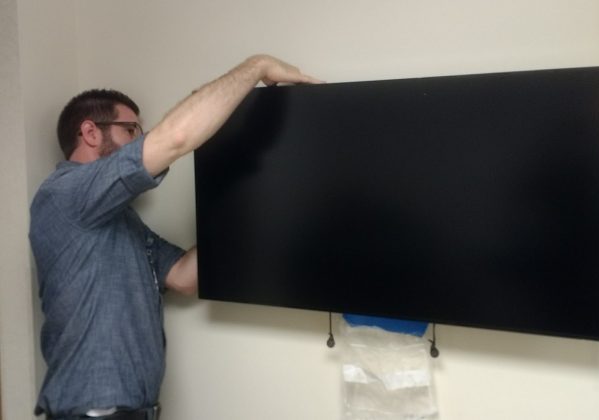
Digital Workplaces installer Scott Currington installs a new digital sign in a physical medicine and rehabilitation break area in University Hospital. (Rob Levitt, Digital Workplaces)
As one of the largest health care systems in the world, communication to the more than 26,000 Michigan Medicine employees is not always easy.
“As an organization, we are continuously looking for new channels to communicate important news and updates to employees,” said Kathleen McCool, employee communications manager with the Michigan Medicine Department of Communication. “Email is not always the most effective or efficient way to let people know what is happening throughout the organization.” A collaborative response from the Department of Communication, Health Information Technology & Services (HITS), Information and Technology Services (ITS), and U-M Facilities provided a solution.
About 270 digital signs are being installed in high employee traffic areas across the main medical campus, satellite clinics, and administrative offices. This uniform approach allows for information to be quickly and easily uploaded, scheduled, and disseminated to employees across facilities, and ensures equal access to important announcements, emergency alerts, traffic updates, weather, upcoming events, employee recognitions, stories, and more.
Digital Workplaces installer Scott Currington and project manager Kyle Matthews have been supporting the project from the beginning and have helped to navigate interaction among the various teams. “It’s kind of like learning a dance. You have to do things in a certain order, like steps,” said Matthews.
HITS teams, including Enterprise and Device Engineering Management (EDEM), Device Ordering, Device Imaging, and Networking, manage complicated tasks like making the computer autonomous and installing signs around the 24/7 work schedule in many medical buildings. The Digital Signage team at ITS provides support and licensing for the Four Winds Interactive Software, and the Department of Communication provides content and governance including look and feel, color palette, and brand guidelines. “The digital signs look like a simple product when you see them hanging up, but there’s a lot of moving parts and a lot of collaboration on the backend between teams to make sure everything works just right,” said Currington.
About 140 signs are planned for the main medical campus in Ann Arbor, with the rest going to administrative offices and satellite clinics. The full project will take about 12 months, with substantial completion slated for the end of December. “From walking the physical spaces across the medical campus for locating the screens, to the complex back-end set-up and installation, the digital signage program was a major project and HITS delivered,” said McCool. “Everyone has been wonderful to work with.”
